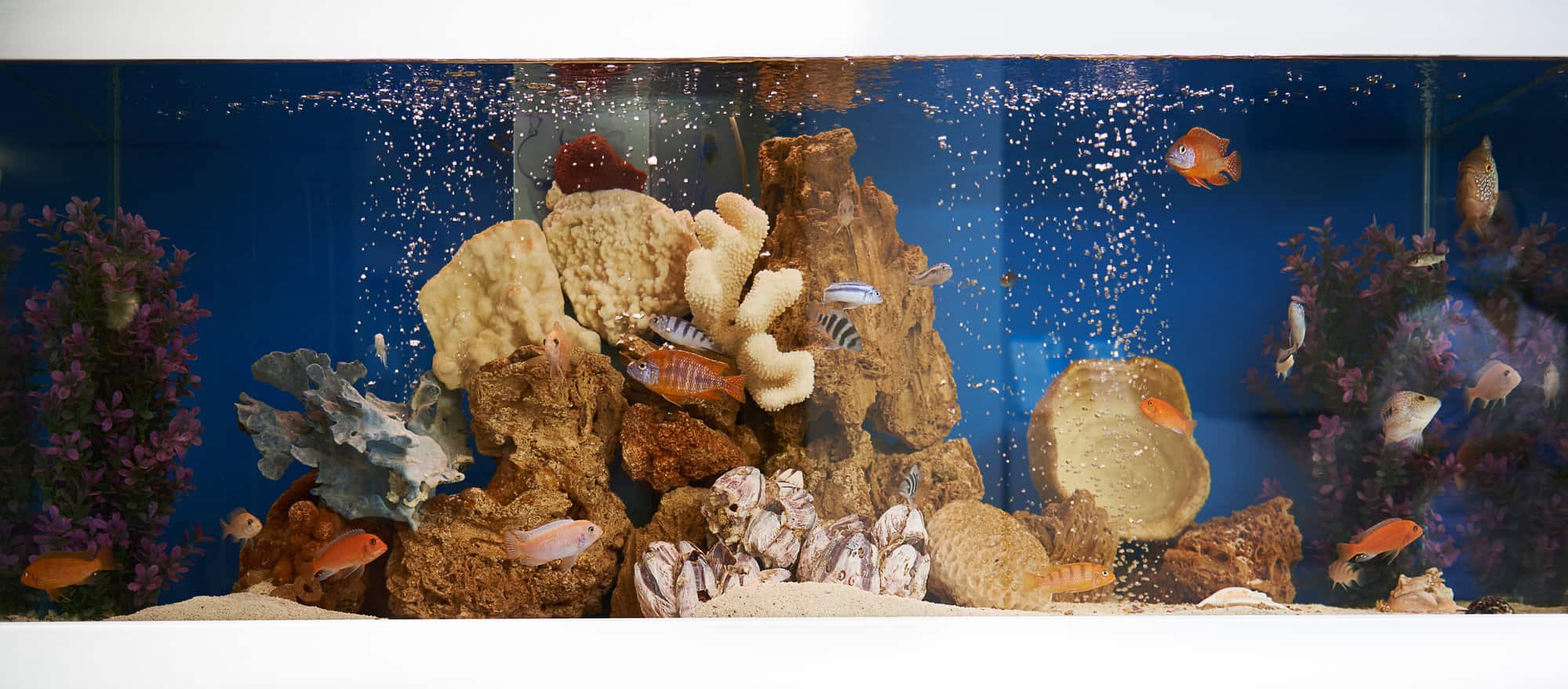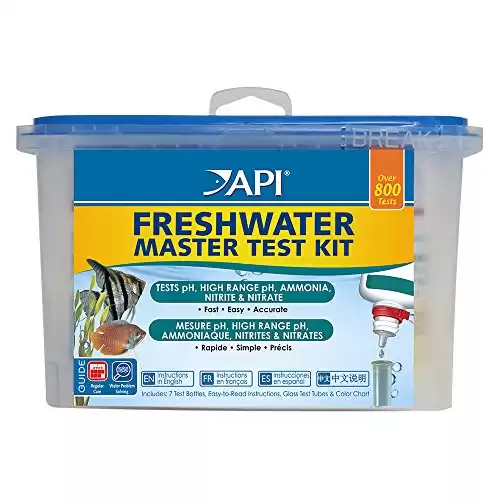When it comes to decorating a fish tank, some of us like to get creative.
For me, nothing can beat an aquascaped aquarium with plenty of plants, stunning rocks, and twisted pieces of driftwood.
But can you include crystals as part of your aquarium decor?
The answer is yes! You can. But you also need to know which ones are safe to use and how some of them might alter your tank’s water chemistry.
In this guide, I’m going to make all of that crystal clear!
What Do We Mean By ‘Crystals’?
The word ‘Crystal’ is actually a very broad and rather ambiguous term!
According to the Britannica Encyclopedia, a crystal is ‘Any solid material in which the component atoms are arranged in a definite pattern and whose surface regularity reflects its internal symmetry.’
According to this definition, even snowflakes or table salt could be considered a crystal.
But we’re not talking about putting snow into your aquarium here! In this case, we’re talking about semi-precious crystalline gemstones such as quartz, jasper, amethyst, and jade.
Why Add Crystal Gemstones To Your Aquarium?
Semi-precious stones and rocks can make extremely beautiful additions to a fish tank.
Popular types of crystals such as Tiger’s Eye and Agate add an original and eye-catching feature to your aquarium substrate.
Many crystals are also fairly inert and won’t make a difference to the pH or water chemistry of your fish tank, making them completely safe additions.
Some people also believe that crystals carry magical benefits to people, plants, and animals surrounding them…
Crystal Therapy
For thousands of years, gemstone crystals have been used for their reputed therapeutic benefits.
Ancient Roman, Egyptian and Greek civilizations used quartz crystals as talismans.
Although there have not been any peer-reviewed scientific studies to verify whether crystals can alter our physiology, believers in gemstone therapy say that gemstones carry the ability to heal our bodies, clear our minds and boost our energy levels.
Whether or not you choose to believe in the healing capacities of gemstones, some fish keepers will certainly add crystals such as quartz and jasper to their tanks, believing they will improve the health and well-being of not only themselves but their fish as well.
Which Crystals Are Safe To Add To Your Aquarium?
Here is a list of crystals that are fairly inert, meaning they won’t react with fresh water and won’t make any significant difference to your aquarium’s water chemistry.
Rock crystals such as Quartz (including Rose Quartz, Smokey Quartz, Apricot Quartz, etc.), Jasper, Citrine, Jade, Ametrine, Tiger’s eye, Amethyst, Agate, Black Tourmaline, and Petrified Wood are all considered safe additions to your aquarium.
As for aquarium rocks, Granite, Rainbow Rock, Onyx, and Quartzite are also fairly inert and make good rocks for soft water aquariums.
Slate and Lava Rock are also relatively inert but can sometimes have sharp edges that can damage fish with sensitive skin.
Sandstone can also be used provided it doesn’t contain any dolomite or limestone.
Which Crystals and Stones Are Potentially Unsafe To Add To An Aquarium?
Some stones, however, have a different chemical composition and can react or begin to dissolve in your water and substantially affect your aquarium water chemistry.
This can, in some instances, be dangerous since each fish species has particular water parameters that they can live in.
If conditions stray outside of this safe range leading to poor water quality, your fish’s health and well-being could be at risk.
Rocks and stones that can alter the pH and water chemistry of your tank include:
Coal, Dolomite, Sandstone, Limestone, Gypsum, Angeline, Halite, Lepidolite, Kunzite, Azurite, Calcite, Pyrite, Fluorite, Celestite, Malachite, and Turquoise.
Using Reactive Rocks and Crystals To Alter Water Chemistry
While most novice fish keepers would be well advised to steer clear of rocks that can affect the water chemistry, advanced aquarists will sometimes use reactive rocks to shift the water chemistry in their favor.
This is normally done when the local tap water is soft and acidic, but the aquarium owner is wanting to keep fish that prefer hard alkaline water.
Fish such as African Cichlids and Mollies, for example, have a strong preference for water that is hard and alkaline and may suffer from health problems such as ‘shimmies’ in soft water with inadequate mineral content.
Rocks like limestone and dolomite act as a pH buffer by constantly releasing small amounts of calcium compounds into the water and raising the water’s pH and hardness.
Crushed coral is also used for this purpose, and is sometimes sold as an aquarium substrate.
Crushed coral should, however, only ever be purchased from reputable, sustainable sources since coral dredging can be incredibly destructive to marine ecosystems.
Are Rough or Smooth Crystals Better For Using In An Aquarium?
If you’ve been shopping for crystals online or in a store, you’ll probably have noticed that some of them are rough, with jagged edges, while others are round and smooth.
These round, smooth versions are either collected from a river bed, by the sea where erosion caused by moving water has made the stones smooth and shiny or made smooth by an artificial process known as ‘rock tumbling’.
Rock or stone tumbling is where rocks and stones are placed into a rock tumbling machine to simulate the effect of natural erosion.
After a day or two, the stones come out with smooth edges, bright colors, and a luxuriant sheen.
Not only are these ‘tumble stones’ or ‘polished stones’ more shiny and colorful than rough-cut stones, but the smooth edges are also easier to clean and pose less threat to your fish too.
Fish with long fins such as betta fish and guppies are especially prone to tearing their fins on sharp rocks, so tumble stones are a great way to avoid this.
Can You Put A Geode In A Fish Tank?
If you’ve ever been into a crystal shop, geodes are those hollow, somewhat spherical rocks, inside which crystals are secluded.
Their highly attractive appearance might have some fish keepers wondering – can I add a geode to my aquarium?
The answer, of course, depends on what your geode is made from. Whereas some geodes are made from an aquarium-friendly rock like granite with quartz inside, others might be made from dolomite and calcite, both of which can affect your aquarium’s water chemistry.
The hollow shape of a geode can also make them more difficult to clean than simple round crystals, and you may struggle to clean algae and biofilm from the rough, angular contours inside a geode.
Placing them in boiling water for 15 minutes, or using baking soda and vinegar might help, but even then it might be difficult to restore such a complex formation to its original glory.
Reducing Algae On Your Aquarium Rocks and Crystals

One of the main obstacles to having sparkling clean, shiny rocks and crystals in your aquarium will be algae growth.
Once algae have begun to cover one of your cherished crystals, they will begin to appear duller and lose their precious sheen.
Your best defense against excessive algae growth in your aquarium is good tank management.
Algae love to grow in poor-quality water that’s full of nitrates and phosphates from fish waste and decaying uneaten fish food.
Keep your gravel and water clean by avoiding overfeeding and by cleaning your gravel and tank filter every two weeks. Also try to keep your aquarium out of direct sunlight coming in through your windows, since this increases algal growth and can also overheat the water.
A cleaning crew of algae-eating tank mates such as Plecos, Otocinclus catfish, Amano shrimp, and Nerite Snails will also do wonders in helping your tank remain relatively algae-free.
How To Add Gemstone Crystal To Your Aquarium
Obtain Your Crystals
First of all, you’ll need to find your crystals.
Gemstones vary in quality from seller to seller, and, as we mentioned, you should try to find stones with smooth edges that will be easier to clean and safer for your fish. Use our list above and only choose safe stones for your aquarium.
Always avoid polished stones with a layer of varnish or lacquer covering them as these can be harmful to your tank environment.
Clean Your Crystals
The next step is to clean your crystals thoroughly.
One way to do this is by placing them in boiling water for 10-15 minutes to give them a deep clean and to sterilize any bacteria or pathogens that might be living on them.
Another method is to use vinegar and a cloth to wipe off any debris or residues. This second method works especially well with small tumble stones. Wash off any vinegar before adding the crystals to the tank.
Avoid chemical cleaners since they might contaminate your aquarium water.
Place Your Crystals in The Aquarium
Now that you’ve cleaned your crystals, it’s time to put them in the water.
Small gemstones can look very nice nestled into the aquarium sand or aquarium gravel substrate, whereas larger crystalline rocks can be stacked up against each other to create caves and hiding places for your fish.
Have fun and create some beautiful rocky features for you and your fish to enjoy.
Avoid stacking rocks against your aquarium glass, however, since rocks can scratch or even crack the glass.
Observe Your Fish
After your crystals and rocks have been added, watch your fish carefully over the next days and weeks to see how they are interacting with the new tank décor.
Are they using the caves you’ve created as hiding places or perhaps you need to make the entrance slightly bigger or smaller?
Also, check that your fish are damaging their fins or scales on sharp rock edges. If your fish are scratching themselves a lot on the rocks, it might mean they have parasites such as flukes, ich, velvet, or anchor worms.
Finally, Test Your Water’s pH
If you think that some of the rocks that you added might affect your water’s pH, it’s important to test your water regularly with a reliable kit to check for changes.
- Accurately monitors 5 most vital water parameters levels in freshwater aquariums: pH, high range pH, ammonia, nitrite, nitrate
- Designed for use in freshwater aquariums only
- Use for weekly monitoring and when water or fish problems appear
We earn a commission if you make a purchase, at no additional cost to you.
After adding rocks, perform a water test twice during the first month, followed by a monthly check thereafter to keep an eye on any changes in the water chemistry.
Now that you’ve created beautiful and safe aquarium crystal décor for your fish, you can sit back and enjoy watching them interact with it.
I especially enjoy watching cave-dwelling cichlids like Kribensis and catfish scurrying around the caves I’ve made.
Let us know in the comments which fish you most enjoy creating caves for!
Conclusion
Adding crystals to your home aquarium can be fun and interesting.
The unique, rich colors and textures of gemstones such as quartz, jasper, and agate can make them a fascinating addition to an aquarium that your fish might enjoy too.
To find out about other interesting ornaments and decorations that you can add to your aquarium, check out our detailed guide to aquarium décor here.



























